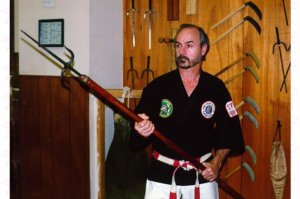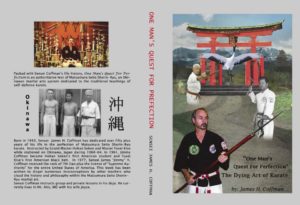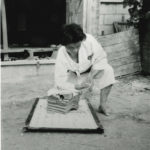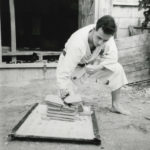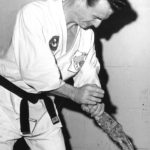“One Man’s Quest for Perfection” is Sensei James “Jimmy” H. Coffman‘s first book about his real-life history with the SHORIN-RYU MATSUMURA ORTHODOX (SEITO) which is a style of martial arts from the Island of Okinawa taught by his two teachers Sensei Kise Fusei and O’ Sensei Hohan Soken. With this informative book comes a DVD packed with actions. Sensei Coffman believes in one rule and lives by it: “The way you train is the way you will carry yourself in a fight out there. If you don’t experience pain in your training nor deliver pain to your opponent, you will never learn the True Essence of Martial Arts”. This book is a “Must Read“.
Here’s what some of our readers say about it:
Liam Renish: “Sir, I ordered your book about a week ago and I’ve already read it. I respected how personal it was and I feel like this is the first book I’ve read that explains the true Okinawan experience, for good or bad. Your book has also inspired me to go back to the basics and work on them whenever I can. Thank you for your contribution to the martial arts.”
Bill Wands: ” I have purchased this book and dvd and both have helped me in my training”
Brian Veach: “One of the books that I think every traditional teacher should have in his library. It sheds some light on where we have come from and why we need to go back! Loved the book, if you are debating on buying, buy it. If you don’t like or enjoy the read I will personally refund your money! No affiliation to James Coffman, other than on here, telling hime how much I enjoyed his TRUE love of the art of karate.”
Rick Turnpaugh: ” Any one interested in real karate as was taught pre 1965, before karate became an after shave, video game, or watered down for kids use, exploited, exported & commercialized… I urge you to pick up a copy of Sensei James Coffman’s book “ONE MAN’S QUEST FOR PERFECTION, THE DYING ART OF KARATE”. Mr. Coffman pulls no punches in telling of his karate training in Okinawa under Sensei Kise and Master Soken in the early 1960s. A very informative look at Shorin ryu karate training as it was taught to a few Americans before it became sport oriented, a time when ones life may depend on wether your karate training was realistic or not! In his book Coffman recalls his introdution to karate, life & death street fights, training methods, and his rare insights gained from seeing & training under several of the last real Okinawan grand masters living in the 20th century.
The book also comes with a dvd featuring Coffman & his students performing many techniques and training methods that have been lost in time due to the watering down of karate for commercial purposes. Highly recommended and an important addition to my own personal library, this book is now available to the general public direct from Jim Coffman, an American karate pioneer and living legend. Don’t just take my word for it, check it out..”
James Quad: “Took your book on vacation with me.. A great read for all martial artists. It really drives home the point that surviving a fight is the primary goal. I’ve three sons. My eldest gets it, he absorbed Shorinji training like a sponge. While in Army Basic Training , he continually frustrated the”Combatives Instructor” with his superior skill level. Nor did he have any trouble with any other opponents, no matter their style.
However, my two younger sons, don’t have the same critical focus or dedication. They are reading your book now and your message appears to be sinking in.
Question, a Japanese/American 7th dan, Shorin ryu, told me that makiwara training was not to be done by anyone younger than 21. It would stunt their growth, by affecting the bones ability to grow. Osborne-san told me makiwara training was good to go age ~16 (mid-puberty). What is your recommendation?”
